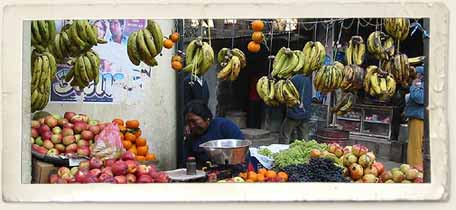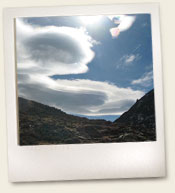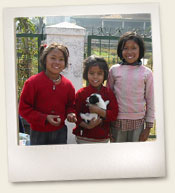General Nepal Information
In the southern part of the giant Asian continent there lies a tiny rectangular kingdom squeezed between two hugely populated countries; China to the north and India to the south, this country is Nepal - a world of its own. The land of contrast is ostensibly the exact way to define the topography of Nepal for you will find maximum world's highest peaks soaring high up above the clouds striving for the gods above. Mt. Everest, Kanchenjunga, Daulagiri, and Annapurna and many more are there for the offering for mountain-lovers, adventurers and trekkers.

No wonder, after viewing the panoramic views of everlasting snow-covered mountain ranges, you find yourself not far below (within a day's distance) busy taking close-up photos of Royal Bengal Tigers prowling in the dense tropical forest. You'll find yourself alongside one-horn Rhinos, Gharials, Crocodiles, and many endangered vertebrate mammals and reptiles, and amidst the friendly native people that consist of 36 colorful ethnic groups.
Therefore, it is not unusual to bask round the snowy peaks in the early morning and take a warm shower under a tropical sun, with the distance covered by your own on-foot journey within a day. The land is also blessed with everlasting peace and tranquility. So for that reason Lord Buddha was born here.
According to Hindu relic (Ramayana), Sita (wife of King Ram) was also born in this particular place. These ancient and medieval relics are still well preserved and full of life. When you witness it, every wall speaks itself. That is why many visitors can't help gasping, and trying hard to retake a gulf of air as the breathtaking views almost took their breath.
Weather in Nepal

Basically, the country experiences four distinct climates annually. Most of the rainfall is being brought by the seasonal reversal of wind direction blown from the Bay of Bengal and vice versa, commonly known as Monsoon. Rain falls mainly between Mid-June to Mid-Sept. and usually during the night.
The latitudinal location of the country plays a limited role in determining the temperature of any particular area owing to the drastic configuration of the landscapes, ranging from the highest point of the world Mt. Everest (third pole) to tropical regions which teem with various endangered species.
Each of the four seasons given below has its own unique feature to quench the thirst of varied tastes of different groups:
Summer (June-Aug)
Sometimes this season extends until mid September and makes your travels wet and warm. As a result the higher valleys and meadows are blossomed with flowers and lush vegetation. This period is blessed for keen botanist.
Autumn (Sept-Nov)
Having undergone a prolonged period of rainy days, the dust in the air is washed out and the sky remains azure blue, and it will allow you to enjoy the views of glittering peaks all around you. This tantalizing mountain views is one of the major attractions of tourists to the country.
Winter (Dec-Feb)
Snow falls where the elevation goes above 2,500m. Hence it is ideal to trek at lower elevation. The minimum temperature goes down to 0-1 degree celcius in Kathmandu. Morning and evening are especially cold and days are warm.
Spring (March-May)
I suppose everybody loves the budding season. Browness is getting a form of greenery; flowers are budding; only a sweater or pullover is needed to avoid feeling cold in the morning and evening. Excellent weather for trekking Nepal, the only the draw back is a bit haze in the sky.
Terrain in Nepal
Nepal is not a large country, roughly 800km long and 200km wide in a rectangular shape. The land can generally be categorised into three areas, the flat plains bordering India in the South that rise into the foothills further north, and the towering Himalayan mountain peaks in the north which borders Tibet. It includes 8 of the 14 highest mountains in the world. It has a total area of over 147181 square kilometres, of which about 17% is forestGeographically, Nepal is divided into three belts:
- Northern Himalayan range
- Middle Mahabharat range
- Southern Terai (plain) belt
Owing to the drastic features of the landscape-configurations of the country, it has possessed several fascinating things that captivate the travellers worldwide to visit once, if not over and over again. The major magnetic attraction for the traveler are:
- Out of 10 highest peaks of the world, eight majestic peaks are found in Nepal. Namely: Everest, Kanchenjunga, Daulagiri, Annapurna I, Manaslu, Lotse, Choyou, and Makalu. There are other numerous nameless peaks, which are soaring above 6000m.
- A wide range of perpetual rushing rivers originate from the upper and middle Himalayas appeals to the rafting enthusiasts.
- Dense deciduous and alpine forest where it has given shelter to many of the unique species found in the world.
People of Nepal

Nepal has a population of around 19 million, which makes the population density about 171 people per square kilometre. The majority maintain a strong Hindu religion. Agriculture is an important part of Nepali life and over three quarters of the population live in rural areas. Life expectancy is around 54 years.
The country consists of 36 ethnic groups, which make it a colorful, impressively cultural, traditional and linguistically diverse region. A greater part of the country still remains untouched by modern civilization and lives in the 'good old days'. After all, it is the genuine hospitality of the host country that makes travellers and trekkers feel at home when they are far away from home.
Nepal Visa Entry
A visa is required to enter Nepal except for Indian nationals. A single entry visa for 60 days can be obtained from any Royal Nepalese Embassy or Consulate upon payment of US$30. You can also get a visa at the point of entry upon arrival. Visitors who require single, double or multiple re-entry visas can get them by paying an additional US$25, 40 and 60 respectively. For extension of visas once you are in Nepal, the Department of Immigration charges US$50 for each additional month. Children under 10 years are not charged any visa fees. This information is subject to change so please consult your nearest Nepalese embassy or consulate for the latest details.
Selected Nepal Links
Nepal Trekking Holidays - additional trekking options.
TrekShare - trekking community with a wealth of information and comments.
Info-Nepal - lots of information and a good list of links.
LonelyPlanet - Comprehensive Nepal and worldwide travel information.
Travel Nepal - information and links on trekking and travel in Nepal.
Trekinfo.com - lots of information and links on trekking in the Nepal Himalaya.
Photos courtesy of Helen & Andrew Purdam.







